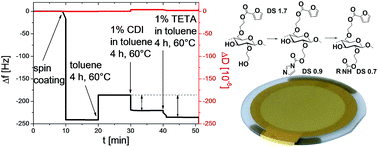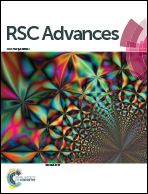Reactive cellulose-based thin films – a concept for multifunctional polysaccharide surfaces
Abstract
Reactive coatings of hydroxyethyl cellulose furoate in the form of thin films, suitable for the covalent immobilization of functional molecules, were developed and characterized in this work. The cellulose furoate derivatives were synthesized under homogeneous conditions by esterification of hydroxyethyl cellulose with 2-furoic acid. Reactive platform layers of these furoates were obtained by chemical surface modification of spin coated thin films with N,N′-carbonyldiimidazole. This chemistry allowed the covalent immobilization of functional molecules bearing primary and secondary amines on the films. The degree of substitution of the furoate thin films and their amino functionalized counterparts was determined gravimetrically by a quartz crystal microbalance (QCM-D) and correlated with infrared and X-ray photoelectron spectroscopy and zeta-potential measurements. Scanning electron- and atomic force microscopy showed changes in the morphologies that were influenced by the chemical reactions on the surface. The concept presented can be seen as a versatile method for immobilizing amine-containing (bio-)molecules to polysaccharide surfaces with the furoates having the potential for further reversible cross-linking in Diels–Alder reactions.


 Please wait while we load your content...
Please wait while we load your content...